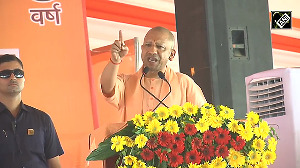The other day, a friend of mine from the United States was telling me about a daring investor who went and purchased land in New Orleans soon after Hurricane Katrina wrecked havoc there.
When I asked him why someone would do that, his retort: "He is a contrarian investor. He picks up land dirt cheap and when construction and rebuilding start after some years he will make phenomenal gains on selling."
Welcome to the world of contrarian investing!
It might have been an alien concept a few years ago but with Asset Management Companies churning out contra funds, numerous investors have caught on to it. The latest being UTI Contra which apparently garnered an amount in the vicinity of Rs 1,200 crore (Rs 12 billion).
Moving against the market?
Contrarian investing means different things to different people. Some view it as buying or selling in the opposite direction in which the market is heading.
So in this current market, a contrarian would be the one who dolefully predicts the end of the Bull Run and who has probably being doing so since the Sensex touched 10,000. And, you certainly won't find him buying anything in this market but, instead, offloading shares.
But on May 17, 2004, when the general election results brought about speculation on the role of the Left parties and the Sensex came tumbling down, the very same contrarian would have been busy picking up stocks at that time.
Courting unloved stocks
However, the most adhered to and acceptable definition refers to someone who buys out-of-favour stocks.
If the short-term price of a stock is higher than its intrinsic value, then it does not make a sound buy. But if it dips lower than intrinsic value, it offers a good opportunity. These are picks that a contrarian will look for.
Sandip Sabharwal, CIO, Lotus Mutual Fund, defines contrarian investing as "picking stocks which have a growth potential but whose value is not reflected in prices."
So when AMCs launch contra funds, they are focussing on turnaround situations and stocks currently undervalued and out of favour.
"It means going against the herd mentality. The rest of the people may be running after a few stocks, the contrarian will go after others. But herd mentality is also reflected when people reject certain stocks. A contrarian will check those out," says Tridib Pathak, CIO, Chola Mutual Fund.
This is no easy task.
Fund managers will typically look at the universe of companies listed and pick those that have not performed well. And then proceed to explore various reasons why this could be so.
By using various fundamental measures such as low P/E (price to earnings ratio), P/B (price to book ratio) or high dividend yield, they sift the wheat from the chaff.
Ultimately, the contrarian must be convinced that the long-term fundamentals are strong enough to outdo the short term glitches.
Manish Bhandari, a fund manager at ING Vysya, admits that the definition of contra is very subjective. "If the stock has value which is not recognised by the market it would make a contra pick," is how he explains contrarian investing.
Picking on a snubbed sector
Before a contrarian zeroes in on a particular stock he may get attracted to a sector for a reason.
When Sandip Sabharwal was the head of equity at SBI Mutual Fund, he invested in the automobile sector in early 2002 when others were giving it the cold shoulder.
He saw certain structural changes that would benefit the sector.
He realised that all had undergone substantial restructuring over the previous five years and were seeing significant volume growth. Volume growth combined with no capital expenditure and consistent cost-cutting was a potent combination in an industry with high operating leverage.
He subsequently picked up Mahindra & Mahindra at Rs 100 levels and Tata Motors at Rs 75 levels.
His advice to contrarians, "go for themes that are underowned."
Bhandari echoes the same sentiment. "A contrarian will look for a sector that is currently out of flavour. For instance, the tyre industry today. A contrarian will study the market and figure out whether or not it may make a turnaround in a year's time. Cement was a contra a year ago."
Turning a deaf ear to the news
Often negative developments of news in the short term may cause some stocks to trade at a discount to their intrinsic value. And when the price is being hammered is the time to make your pick.
Take the case of Pfizer. In February 2004, the company recalled Gelusil liquid from the market due to odour-related issues. That quarter, it was estimated that the sales hit taken on account of this was around Rs 2.5 crore.
On February 20 that year, the stock was Rs 513 and then fell to Rs 390 by June 24.
At that time, it would have made an excellent contra bet because over time the stock price kept rising to Rs 745 in June 2005 and was Rs 1,086 by April 20, 2006. (Prices are the day's high).
People are highly emotional creatures, whether it comes to love or money. Consequently, investors overreact to both good and bad news. So they view a stock with great optimism or rampant pessimism.
It can all be summed in the words of US contrarian market trader Humphrey Neill, "When everybody thinks alike, everybody is likely to be wrong."
Thinking out of the box
A friend of mine keeps regretting that he never picked up Bombay Dyeing a few years ago. The company owns plenty of land and when the prices of land were low, it would have made for a good contra bet. Anybody who thought of it then would have made a killing in this real estate boom which has pushed up the price of Bombay Dyeing to Rs 790 levels.
A contrarian is normally attracted to a point of view that has not been thought of or an aspect that has been ignored. And on this, he places his bets.
Sabharwal speaks of the auto sector which would have made a good contrarian buy a year ago. "Steel prices were up, interest rates were to go up, sales were down and margins were down. But a contrarian would have realised that steel prices had touched a peak and could not go higher and would most likely fall." he explains.
Contra now?
One wonders if there are any contra picks left in such a broad based market rally. A diversified equity fund manager claims that HPCL and BPCL are the only true contra picks right now.
Bhandhari is of the opinion that the state of the market is irrelevant when making a contra call. "However, by definition, since contra stocks are scrips which have not performed / participated or overlooked by investors, in general the erosion in the stock price would be less relative to growth stocks which are over owned in a bull run," he says.
Sabharwal speaks of steel as a contra bet now. And surprisingly, even technology. "Everyone is looking at capital equipment and infrastructure as there is no momentum in tech stocks," he explains.
In fact, a look at the Chola Contra fund portfolio revealed Infosys as a holding (according to March 31 portfolio disclosure) -- which is rather surprising.
However, their logic too stemmed from the fact that the tech sector is being ignored and hence Infosys found a place in the portfolio.
According to Pathak, the stock entered the portfolio on February 21, 2006 as Infosys had risen by only 31% over last one year whereas the market was up by about 50% or so. In fact, the entire IT services sector has underperformed the market over the last one year or so.
"In the rally over the last two years, herd mentality focussed more on infrastructure and domestic stories and ignored the strong and sustainable earnings growth of the IT services sector and especially fundamentally sound companies like Infosys," he explains.
ING Vysya A.T.M (an acronym for Against The Market) also revealed Wipro and TCS in the portfolio (March 31 portfolio disclosure).
"In the last three months prior to that date, IT was a laggard sector," Bhandari explains. The stock price hardly captured the potential of the sector resulting a huge valuation gap. Hence it made for a good contra call at that time."
Sabharwal also suggests mid-caps as a contra bet. "There is a deluge of money in the market. It makes no sense for foreign investors to buy into mid-caps because they are largely illiquid. Consequently, many mid-caps have underperformed," he asserts.
Where does that leave you?
Making right contra picks is no picnic.
Being a steadfast and committed contrarian is the toughest role to fill in stock investing. It requires insight, courage and conviction. And lots of patience. It may be years before the market finally realises the worth of the stock and the prices begin to move upwards.
Some feel this is a risky proposition because you are picking stocks that the market has ignored and there could be a valid reason that it has done so.
Others are of the opinion that they are the best ones in which you can make a killing. These stocks have already been beaten down so the risk of downside is much less.
Moreover, these stocks tend to be less susceptible to price declines in bear markets because expectations about their performance are already low. Hence, it is actually a lower risk method for seeking superior returns.
"There is no data or any indicators such as beta analysis and standard deviation to indicate whether or not a contra fund is more risky than a diversified equity fund," says Bhandari.
If you do fancy this investment philosophy, a better route would be to check out the various contra funds from Tata, UTI, Chola, SBI, INF Vysya and Kotak.
However, Dhirendra Kumar is not upbeat on them. "The only true contra fund was Magnum Contra when it was launched in July 1999. At that time everyone began to get interested in tech stocks but this fund steered clear of the sector," says the CEO of the mutual fund research organisation, Value Research. "Now, all contra funds, including Magnum Contra, are basically diversified equity funds functioning under the pretense of contra funds."
Other than Magnum Contra which has been around since July 1999, all the other contra funds are very new. Here is a look at the players and the Net Asset Values of their growth schemes.
|
|
NAV |
Launched |
|
Chola Contra |
10.76 |
Feb 2006 |
|
ING Vysya A.T.M |
10.47 |
Feb 2006 |
|
Kotak Contra |
14.839 |
Jul 2005 |
|
Magnum Contra |
35.01 |
Jul 1999 |
|
Tata Contra |
12.17 |
Oct 2005 |
|
UTI Contra |
10.22 |
Mar 2006 |
And remember, contra funds are not another sector. They are all diversified equity funds with a different philosophy. If you believe in it, you could think of channelising some of your savings (not all) into such an investment avenue.






 © 2025
© 2025